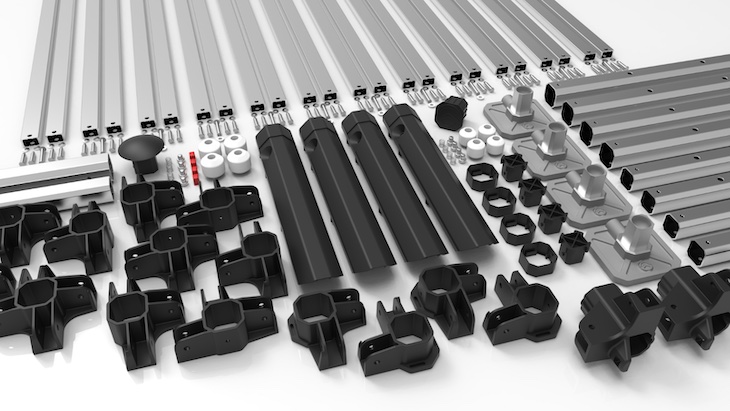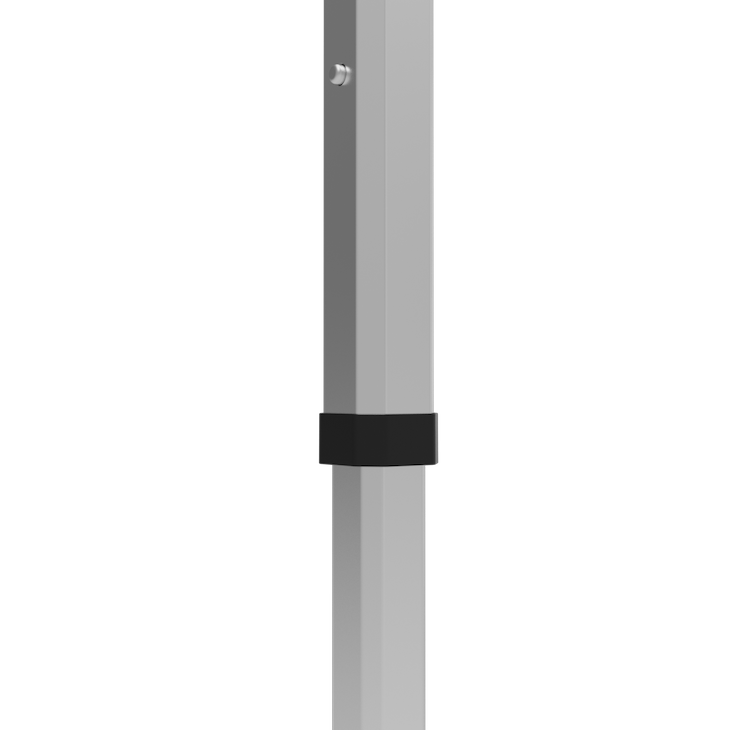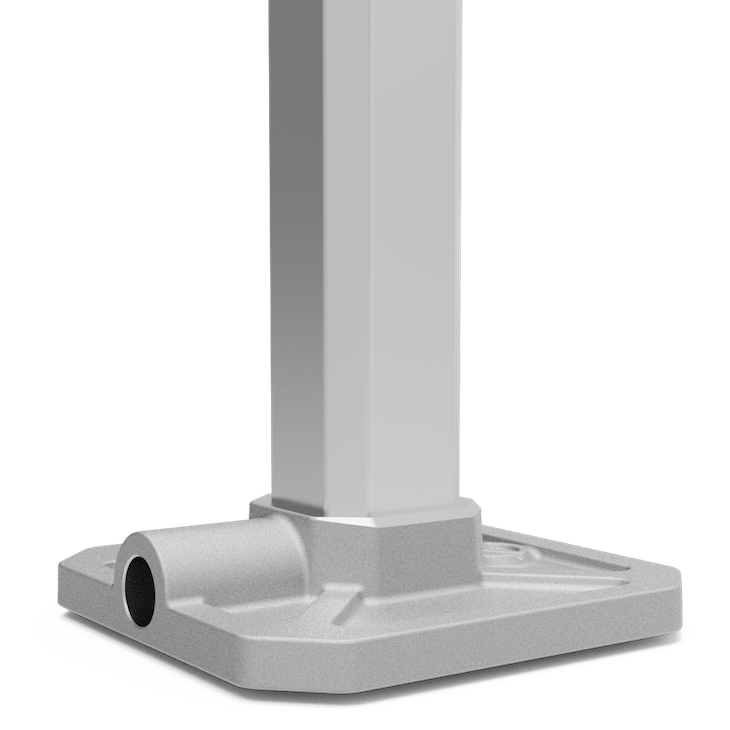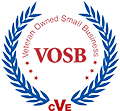A medium-duty pop-up tent is a professional-grade structure using an aluminum frame and engineered plastic connectors. It’s more business than pleasure, and it comes at a price that’s approachable for small business owners and those who need multiple tents for events or other applications.
But there’s way more to it than that.
As the only American manufacturer of pop-up tents in the U.S., TentCraft has developed two pop-up tent models — mightyTENT and MONARCHTENT. Mighty is a medium-duty pop-up tent; Monarch is our heavy-duty solution.
We like to say our medium-duty tent is the perfect solution if you're personally setting it up and properly ballasting it every time. You can expect consistent quality and a very long lifespan. If someone else — think high school or college athletes or event crews — will be typically setting up and caring for your tent, we recommend going with our heavy-duty solution.
Because our team of engineers, metal fabricators, sewers, and product specialists live and breathe these tents every day, we’re in a good position to educate buyers on the key differences between these two tents, specifically their durability in rough weather.
This article is going to specifically touch on medium-duty tents. (Click over here to learn what makes a tent heavy duty.)
The Anatomy of a Medium-Duty Pop-Up Tent

Frame Material: Anodized Aluminum
A medium-duty pop-up tent features an anodized aluminum frame for exceptional durability.
The biggest difference between a recreational pop-up tent and a professional-grade solution is the material of the frame. Frames of cheap recreational tents are steel; professional-grade tents are made of anodized aluminum.
Steel is significantly cheaper to source, so companies like E-Z UP can sell a pop-up tent for about $150. Steel is also significantly heavier and denser than aluminum, meaning the weight of your tent adds up pretty quickly. That’s why steel tent legs tend to be quite thin and are more susceptible to breaking. Steel is also more prone to rust, which cuts down on the lifespan of a tent.
On the other hand, aluminum is a third of the weight of steel, allowing manufacturers like us to produce extra-thick tent legs for greater durability. And when aluminum is anodized, the oxide layer on the surface becomes nearly as hard as diamond. As a bonus, anodized aluminum is also corrosion-resistant.
Our medium-duty mightyTENT uses 12-gauge aluminum, meaning the leg is about 2mm thick — double the thickness of a typical recreational pop-up tent.
Connecting Joints: Engineered Plastic

The biggest difference between a medium-duty tent and a heavy-duty tent is the material used for the connecting joints. Our heavy-duty pop-up tent uses aluminum joints, while our medium-duty solution uses an engineered, glass-filled nylon plastic.
Using engineered plastic in our medium-duty tent keeps cost down compared to the aluminum connectors we use in heavy-duty tents.
Leg Design and Diameter

Most medium-duty pop-up tents feature a square leg design. TentCraft opts to use an octagonal leg design on its medium-duty tent, which allows for better grip and a larger surface area for greater stability.
The leg diameter is about 2 inches, which is plenty big for standing up to tough conditions.
Footpad Design

Many companies overlook the design of a tent’s footpad, but we feel it’s a pretty important part of the tent. After all, you’re likely going to be dragging this thing across a parking lot, so you want something that’s going to hold up.
We feel so strongly about footpads that our heavy-duty tent and medium-duty tent share a very similar footpad design. They feature a cast aluminum footpad that’s about ¼-inch thick.
Cheaper tents, well… cheap out on footpads. They’re typically made of steel and are about ⅛-inch thick.
Frame Weight
You need to find a sweet spot when it comes to the weight of a pop-up tent. A 500-pound tent would perform pretty well against high winds, but it’s also next to impossible to transport.
On the other hand, a steel tent weighing in at 25lbs is easy to transport, but definitely won’t hold up when the weather gets questionable.
Since our heavy-duty and medium-duty frames use higher-gauge aluminum, we use more material, which results in a heavier tent. Our 10x10 pop-up tents weigh in between 60lbs and 70lbs with the canopy attached. We find that weight to be adequate for a person to set up the tent on their own.
And don't worry about transporting the tent from your car to your setup location. We include a handy transport wheel kit with all of our pop-up tents.
High-Quality Canopy

A pop-up tent is only as good as its custom-printed canopy. Most companies opt for a polyester material that’s decent against rain and looks good in the process.
TentCraft takes it a step further. We’ve developed a proprietary fabric called Duranti that’s approved for rugged outdoor use. It’s water, mildew, and UV resistant.
To ensure your canopy lasts a really long time, we’ve reinforced the corners — the spot that rubs the most against the frame — with heavy-duty vinyl that drastically cuts down on everyday wear and tear.
And to guarantee your canopy looks good, our canopies are wrinkle-free and won’t sag when properly installed.
Custom-Printed Canopy
We print our medium-duty pop-up canopies using dye-sublimation printing technology, which means the ink is actually absorbed into the fabric, preventing future cracking or peeling.
Who Uses a Medium-Duty Pop-Up Tent?
Medium-duty tents are popular among farmers market vendors, nonprofit agencies, and high school sports teams.
These customers have tighter budgets but need a quality solution to avoid purchasing a new tent each year.
TentCraft also has many agency clients who make bulk orders of medium-duty tents to keep project costs low for one-off events.
Wind Ratings of Medium-Duty Tents
Medium-duty tents typically don’t include a certified wind rating.
However, that doesn’t mean they can’t hold up against everyday weather when properly ballasted.
When properly staked or using our 50-pound footplates, you can feel comfortable using your tent in everyday winds.
We always like to remind customers to be safe rather than sorry. If winds pick up to the point where your hat is blowing off your head, it’s safer to fold it up until the weather subsides.
Warranty of Medium-Duty Tents
We’re so confident in our medium-duty tents that we include a 5-year frame warranty and a 7-year, pro-rated canopy warranty. If something fails due to a manufacturer’s error, we’ll repair or replace it for free.
Cost of Medium-Duty Tents
One of the biggest advantages of a medium-duty tent over its heavy-duty counterpart is cost. Because a medium-duty tent uses less material, it’s more affordable.
Expect to pay about $1,500 for a medium-duty tent, which is about half the starting price of a heavy-duty tent.
Of course, the final price depends on several factors, including the amount of printing, add-ons, and shipping location.
Invest in a Medium-Duty Tent
Now armed with more than you wanted to know about medium-duty tents, it’s time to start your custom tent project. Reach out to a product specialist today, and let’s create something great.


